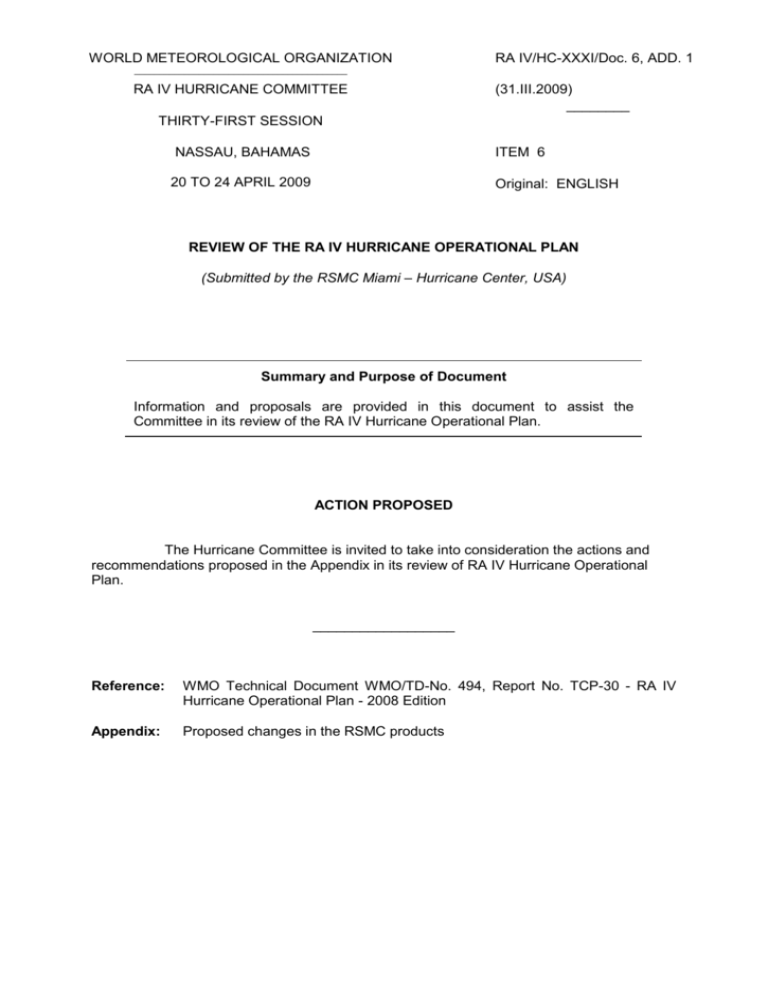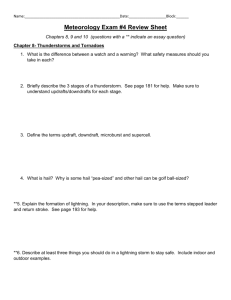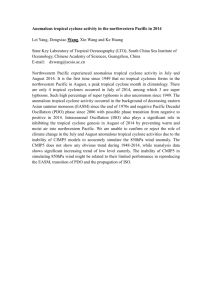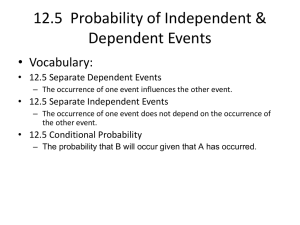English
advertisement

WORLD METEOROLOGICAL ORGANIZATION
RA IV/HC-XXXI/Doc. 6, ADD. 1
___________________________________________
RA IV HURRICANE COMMITTEE
(31.III.2009)
________
THIRTY-FIRST SESSION
NASSAU, BAHAMAS
ITEM 6
20 TO 24 APRIL 2009
Original: ENGLISH
REVIEW OF THE RA IV HURRICANE OPERATIONAL PLAN
(Submitted by the RSMC Miami – Hurricane Center, USA)
Summary and Purpose of Document
Information and proposals are provided in this document to assist the
Committee in its review of the RA IV Hurricane Operational Plan.
ACTION PROPOSED
The Hurricane Committee is invited to take into consideration the actions and
recommendations proposed in the Appendix in its review of RA IV Hurricane Operational
Plan.
__________________
Reference:
WMO Technical Document WMO/TD-No. 494, Report No. TCP-30 - RA IV
Hurricane Operational Plan - 2008 Edition
Appendix:
Proposed changes in the RSMC products
RA IV/HC-XXXI/Doc. 6, ADD. 1, APPENDIX
1.
To Issue Special Tropical Weather Outlooks in lieu of Special Tropical
Disturbance Statements (DSA) - ( information)
DISCUSSION: Special DSAs are issued when there have been important changes with
areas of disturbed weather over tropical or subtropical waters that need to be conveyed
before the next scheduled release of the Tropical Weather Outlook. It can also be used on a
recurring basis for disturbances outside of the normal hurricane season when Tropical
Weather Outlooks are not issued. The DSA is analogous to a Special Tropical Cyclone
Advisory, which is issued whenever an unexpected significant change has occurred between
regularly scheduled advisories. Since having two products, each with the same scope and
content, is inefficient from an administrative, programming, and outreach perspective,
replacing the DSA with a Special TWO is preferred. Consolidation of two products into one
would also greatly facilitate incorporation of the most up to date information on the Graphical
TWO (GTWO) and new NHC “status map” (home page clickable map). Updating the
GTWO and status map with information from the DSA is currently problematic, and replacing
the DSA with a Special TWO would facilitate further improvements and enhancements to
these popular graphics.
An alternative would be to issue an “amended” TWO. This, however, would seem to be
inappropriate for use outside of the hurricane season. In addition, the TWO (text form) will
include the likelihood of tropical cyclone formation expressed as one of three possible
levels: low, medium, and high.
Example of Special Tropical Weather Outlook:
ABNT20 KNHC 161145
TWOAT
SPECIAL TROPICAL WEATHER OUTLOOK
NWS TPC/NATIONAL HURRICANE CENTER MIAMI FL
1045 AM EDT WED JUL 16 2008
FOR THE NORTH ATLANTIC...CARIBBEAN SEA AND THE GULF OF MEXICO...
SPECIAL OUTLOOK ISSUED TO UPDATE DISCUSSION OF LOW PRESSURE AREA
EAST OF THE WINDWARD ISLANDS.
THE NATIONAL HURRICANE CENTER IS ISSUING ADVISORIES ON TROPICAL
STORM BERTHA...LOCATED ABOUT 335 MILES NORTHEAST OF BERMUDA.
UPDATED...SATELLITE IMAGES AND SURFACE OBSERVATIONS INDICATE THAT THE
AREA OF LOW PRESSURE LOCATED ABOUT 225 MILES EAST OF THE WINDWARD
ISLANDS HAS BECOME BETTER-ORGANIZED AND A TROPICAL DEPRESSION COULD
BE FORMING. AN AIR FORCE RESERVE HURRICANE HUNTER AIRCRAFT WILL BE
INVESTIGATING THIS SYSTEM THIS AFTERNOON TO DETERMINE IF A TROPICAL
CYCLONE HAS FORMED. EVEN IF NO DEVELOPMENT OCCURS...LOCALIZED HEAVY
RAINS AND GUSTY WINDS ARE POSSIBLE IN THE WINDWARD ISLANDS TODAY AND
TONIGHT. ALL INTERESTS IN THE WINDWARD ISLANDS SHOULD MONITOR THE
PROGRESS OF THIS SYSTEM...AND FOR INFORMATION SPECIFIC TO YOUR
AREA...PLEASE CONSULT STATEMENTS FROM YOUR LOCAL WEATHER OFFICE.
THERE IS A HIGH CHANCE...GREATER THAN 50 PERCENT...OF THIS SYSTEM
BECOMING A TROPICAL CYCLONE DURING THE NEXT 48 HOURS.
ELSEWHERE...TROPICAL CYCLONE FORMATION IS NOT EXPECTED DURING THE
NEXT 48 HOURS.
FORECASTER BLAKE/AVILA
RA IV/HC-XXXI/Doc. 6, ADD. 1, APPENDIX, p. 2
RECOMMENDATION: Eliminate the DSA product. Issue a Special TWO for situations
when important changes with areas of disturbed weather over tropical or subtropical waters
need to be conveyed before the next scheduled release of the TWO, and when needed
outside of the hurricane season.
ACTION: Recommendation accepted in NOAA. Forward to RA-IV HC. Change it in the
Operational Plan.
2.
Tropical Cyclone Discussion Issuance Time Zone - (information)
DISCUSSION: In the Atlantic basin, the Public Advisory issuance time zone varies with
cyclone location, but the Tropical Cyclone Discussion is expressed in a fixed local time zone
(Eastern), regardless of the cyclone location. As a result, the two products frequently are
issued in two different time zones, which may cause some confusion for users. This is not a
problem in the eastern and central Pacific basins, where a single local time zone is used for
both the Public advisory and the Discussion.
RECOMMENDATION: Change the issuance time zone for the Discussion to be consistent
with the companion Public Advisory. Forward to RA-IV HC. Change it in the Operational
Plan
Affected products are:
WMO-HDR
CCID
Description
WTNT4{1-5} KNHC
Atlantic Tropical Cyclone Discussion
WTPZ4 {1-5} KNHC
WTPA4 {1-5} KNHC
East Pacific Tropical Cyclone Discussion
Central Pacific Tropical Cyclone Discussion
3.
Use of “Z” time in Tropical Cyclone Public Advisory - (information)
DISCUSSION: The Tropical Cyclone public advisory utilizes “Z” to denote times in
Coordinated Universal Time; however, per directives that time must be denoted as “UTC.”
RECOMMENDATION: Change the “Z” to “UTC” pursuant to NWS Directives and issue
notice to all users concerning the change.
Affected products are:
WMO-HDR
CCID
WTNT3{1-5} KNHC
WTPZ3{1-5} KNHC
WTPA3{1-5} KNHC
Description
Atlantic Public Advisory
East Pacific Public Advisory
North Central Pacific Public Advisory
ACTION: Recommendation accepted in NOAA.
Operational Plan
4.
Forward to RA-IV HC. Change in the
Discontinue Monthly Tropical Weather Summaries in Atlantic, Eastern and
central North Pacific Basins
DISCUSSION: The National Hurricane Center and Central Pacific Hurricane Center issue
monthly Tropical Weather Summaries (TWSs) during the hurricane season. According to
Instruction 10-601 the products contain"...such items as description of strength, intensity,
RA IV/HC-XXXI/Doc. 6, ADD. 1, APPENDIX, p. 3
motion, impacts, and dates and times of occurrence. The TWS provides a brief summary of
tropical cyclone activity during the preceding month. Monthly updates permit a timely
release of tropical cyclone information. In addition to the TWS, NHC and CPHC prepare and
submit a formal, detailed season summary which involves a lengthy review and publication
process."
In practice, the TWS products usually can only provide weather information already issued
through operational products in real time, and very preliminary casualty and damage
estimates already published by the media. "Post-storm" analyses and descriptions, such as
contained in Tropical Cyclone Reports (TCRs) of the hurricane centers using input from
WFOs and international meteorological services for land-falling storms and subject to a
review process, almost always take more than a month to complete. TWSs are therefore
typically either a mixture of operational and final information, or only operational information.
When TCRs do become available they immediately make the TWS products obsolete. This
has always raised doubts about the utility of the TWSs. Those doubts were shown to be
warranted when due to their operational workload the NHC could not generate and issue its
August 2008 TWS products for the Atlantic and eastern North Pacific basins. That month
contained all or part of the evolution of land-falling hurricane/storms Edouard, Fay, Gustav
and Hanna. Yet, NHC received no complaints and, in fact, no inquiries about the un-issued
products--including to the high-volume e-mail in box of the NHC's webmaster--for more than
two weeks.
These products also can take considerable time to develop, time that either is not available
when there are on-going storms near the end of the month, or time away from work on
operations.
RECOMMENDATION: Discontinue RSMC Miami and Honolulu TWS products.
ACTION: Recommendation not accepted in NOAA. Content will change and the TWS will
now consist only of a table of basic statistics for each cyclone and a short narrative of
records of interest, if any. RSMC will update the web page product description. Forward to
RA-IV HC.
5.
Modify repeat section in public advisories (information)
ACTION: RSMC Miami will modify the “repeat” section of the TCP to aid in the parsing of
critical advisory information accepted (see below). Forward to RA-IV. Change it in the
Operational Plan
Example of new storm summary section in the TCP
...SUMMARY OF 1100 PM AST INFORMATION...
LOCATION...23.7N 72.2W
MAXIMUM WINDS...40 MPH
PRESENT MOVEMENT...WEST OR 275 DEGREES AT 8 MPH
MINIMUM CENTRAL PRESSURE...1001 MB
Example with stationary motion
...SUMMARY OF 500 PM PDT INFORMATION...
LOCATION...19.7N 101.6W
MAXIMUM WINDS...100 MPH
PRESENT MOVEMENT...STATIONARY
MINIMUM CENTRAL PRESSURE...965 MB
________







